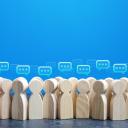Andrew Chien, the newly appointed William Eckhardt Professor in Computer Science, projects that the 10-year future of computer hardware will be “wildly different” from the past 10 years. Chien, who was vice president of research at Intel Corporation from 2005 to 2010, believes the coming changes in computer science, in general, will be the result of shared research. He’s especially optimistic about the possibilities at UChicago.
“Concentrated excellence allows people to work across disciplines in a way that often doesn’t happen at big institutions,” said Chien, who also has taught at the University of California, San Diego, and the University of Illinois at Urbana-Champaign. “And I believe the most important discoveries of the next few decades will be made in interdisciplinary and multidisciplinary collaborations.”
Chien is one of a handful of new members of the University’s Computer Science faculty who are changing the face of the department as it expands beyond its theoretical foundations. He specializes in systems applications, software, networking, and computer architecture, an applied form of computer science.
“This is a game-changing appointment,” said Robert Fefferman, dean of the Physical Sciences Division. “Chien is a top systems person who is well known for organizing outstanding groups of faculty in systems, and we want to pursue that here,” he added.
Also joining the faculty is John Lafferty, the Louis Block Professor in Statistics and Computer Science. With expertise in machine learning, Lafferty will strengthen the bridge between Computer Science and Statistics departments that has been in place for a number of years. “One of the things we have that’s close to unique is a very strong sense of cooperation between statistics and computer science,” said Computer Science Department Chairman John Goldsmith, the Edward Waller Carson Distinguished Service Professor in Computer Science and Linguistics.
“Yali Amit is the chair of statistics and he’s a member of the Computer Science Department. And when Steve Stigler was chair of statistics, we had a really strong working relationship,” Goldsmith said.
Lafferty, who will begin teaching during the Winter Quarter, is coming to Chicago from Carnegie Mellon University. His specialty in machine learning involves teaching a computer how to learn from experience to perform tasks that a human could do, or could do less efficiently.
“John Lafferty is one of the top authorities in this field of machine learning in the world,” Fefferman said.
Risi Kondor, a new assistant professor in computer science and statistics, shares Lafferty’s interests in machine learning and statistics. Kondor received his PhD from Columbia University, and then completed postdoctoral appointments at University College London and the California Institute of Technology.
The Computer Science department also is welcoming the National Science Foundation’s 2010 Alan T. Waterman Award recipient, Subhash Khot, who will serve a two-year term as a visiting professor. NSF’s Waterman award, which includes a $500,000 grant, is given annually to an outstanding researcher in science or engineering under the age of 36.
A theoretical computer scientist, Khot investigates the power and limits of efficient computation, a field called computational complexity. Khot’s research complements the work of Alexander Razborov, the Andrew MacLeish Distinguished Service Professor in Computer Science, who also specializes in the computational complexity field.
Razborov received the 1990 Rolf Nevanlinna Prize, awarded quadrennially for outstanding contributions to mathematical aspects of information sciences. Razborov joined the UChicago faculty in 2008. “He clearly is one of the very best theoretical computer scientists of our time,” Fefferman said.
The Computer Science Department also is a finalist, with partner Toyota Technological Institute, in a Simons Foundation grant competition to establish an Institute for the Theory of Computing. The foundation will announce the winner next year.
Chien, meanwhile, forges ahead in applied computation. The changes he predicts in computer hardware include a move toward parallelism, or multicore computing, which began several years ago.
This trend grew out of stagnant clock rates, which determine computer-processing speed. Clock rates for personal computers had grown increasingly faster until several years ago. “Clock rates are not going up any more,” he said.
“The second big change that we’re just seeing the beginning of is heterogeneity,” a trend toward more variety in computer architecture. Today, nearly all of the central processing units—CPUs, or the engines of a computer—typically employ the same general-purpose architecture in printers, personal computers or servers.
“What’s increasingly clear is that over the next 10 years we’re going to see specialization of those architectures,” Chien said. Almost every machine now contains both a CPU and a GPU (graphics processing unit), which require completely different architectures. “Over the next 10 years there may be as many as 10 of those specialized engines in every microprocessor that gets sold.”
The big change beyond that will be the end of Moore's law, the computer industry standard that the number of transistors on a microchip should double every 18 months, Chien said. “That’s a much bigger change, and we don’t know what that’s going to look like.”






